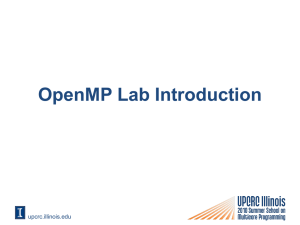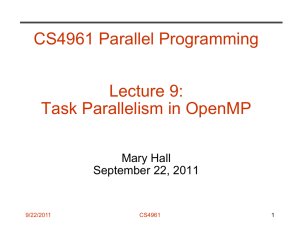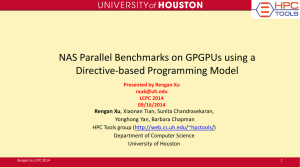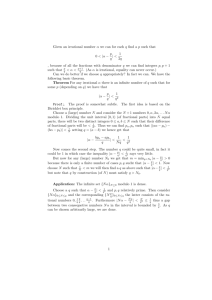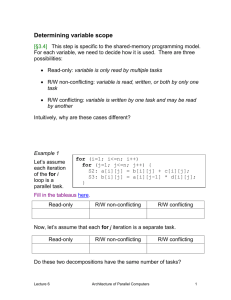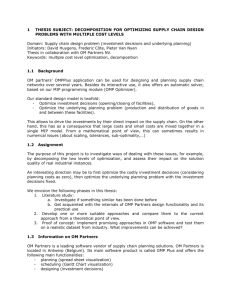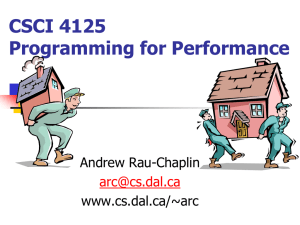What's new in OpenACC 2.0 and OpenMP 4.0 - GTC On
advertisement
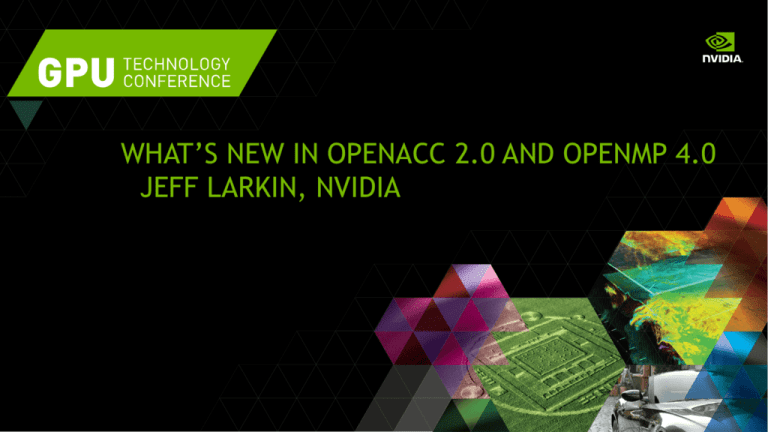
WHAT’S NEW IN OPENACC 2.0 AND OPENMP 4.0
JEFF LARKIN, NVIDIA
OUTLINE
Background on OpenACC and OpenMP
New features in OpenACC 2.0
— Routine Directive
— Unstructured Data regions
— Atomics
— Multiple Device Types
New features in OpenMP 4.0
— Target Data Construct
— Target Construct
— Teams/Distribute
2
OPENACC 2.0
OpenACC is a specification for high-level, compiler directives
for expressing parallelism for accelerators.
— Aims to be performance portable to a wide range of accelerators.
— Multiple Vendors, Multiple Devices, One Specification
The OpenACC specification was first released in November
2011.
— Original members: CAPS, Cray, NVIDIA, Portland Group
OpenACC 2.0 was released in June 2013, expanding
functionality and improving portability
At the end of 2013, OpenACC had more than 10 member
organizations
3
OPENACC EXAMPLE: SAXPY
SAXPY in C
SAXPY in Fortran
void saxpy(int n,
float a,
float *x,
float *restrict y)
{
#pragma acc parallel loop
for (int i = 0; i < n; ++i)
y[i] = a*x[i] + y[i];
}
subroutine saxpy(n, a, x, y)
real :: x(n), y(n), a
integer :: n, i
...
// Perform SAXPY on 1M elements
saxpy(1<<20, 2.0, x, y);
...
...
! Perform SAXPY on 1M elements
call saxpy(2**20, 2.0, x, y)
...
!$acc parallel loop
do i=1,n
y(i) = a*x(i)+y(i)
enddo
!$acc end parallel loop
end subroutine saxpy
4
OPENMP 4.0
OpenMP has existed since 1997 as a specification for compiler
directives for shared memory parallelism.
In 2013, OpenMP 4.0 was released, expanding the focus
beyond shared memory parallel computers, including
accelerators.
The OpenMP 4.0 target construct provides the means to
offload data and computation to accelerators.
Additional directives were added to support multiple thread
teams and simd parallelism.
OpenMP continues to improve upon its support for offloading
to accelerators.
5
OPENMP’S NEW MISSION STATEMENT
"Standardize directive-based multi-language high-level
parallelism that is performant, productive and portable."
6
OPENMP TARGET EXAMPLE: SAXPY
SAXPY in C
void saxpy(int n,
float a,
float *x,
float *restrict y)
{
#pragma omp target teams \
distribute parallel for
for (int i = 0; i < n; ++i)
y[i] = a*x[i] + y[i];
}
...
// Perform SAXPY on 1M elements
saxpy(1<<20, 2.0, x, y);
...
SAXPY in Fortran
subroutine saxpy(n, a, x, y)
real :: x(n), y(n), a
integer :: n, i
!$omp target teams &
!$omp& distribute parallel do
do i=1,n
y(i) = a*x(i)+y(i)
enddo
!$omp end target teams &
!$omp& distribute parallel do
end subroutine saxpy
...
! Perform SAXPY on 1M elements
call saxpy(2**20, 2.0, x, y)
...
7
NEW FEATURES IN OPENACC 2.0
OPENACC ROUTINE DIRECTIVE
The routine directive specifies that the compiler should generate a device
copy of the function/subroutine in addition to the host copy.
Clauses:
gang/worker/vector/seq
— Specifies the level of parallelism contained in the routine.
bind
— Specifies an optional name for the routine, also supplied at call-site
no_host
— The routine will only be used on the device
device_type
— Specialize this routine for a particular device type.
9
OPENACC ROUTINE: BLACK SCHOLES
///////////////////////////////////////////////////////////////////////////////
// Polynomial approximation of cumulative normal distribution function
///////////////////////////////////////////////////////////////////////////////
#pragma acc routine seq
real CND(real d)
{
const real
A1 = (real)0.31938153;
const real
A2 = (real)-0.356563782;
const real
A3 = (real)1.781477937;
const real
A4 = (real)-1.821255978;
const real
A5 = (real)1.330274429;
const real RSQRT2PI = (real)0.39894228040143267793994605993438;
real
K = (real)1.0 / ((real)1.0 + (real)0.2316419 * FABS(d));
real
cnd = RSQRT2PI * EXP(- (real)0.5 * d * d) *
(K * (A1 + K * (A2 + K * (A3 + K * (A4 + K * A5)))));
if(d > 0)
cnd = (real)1.0 - cnd;
return cnd;
}
10
UNSTRUCTURED DATA REGIONS
OpenACC 2.0 provides a means for beginning and ending a data
region in different program scopes.
double a[100];
double a[100];
#pragma acc data copy(a)
{
// OpenACC code
}
#pragma acc enter data copyin(a)
// OpenACC code
#pragma acc exit data copyout(a)
11
UNSTRUCTURED DATA REGIONS: C++ CLASSES
class Matrix {
Matrix(int n) {
len = n;
v = new double[len];
#pragma acc enter data create(v[0:len])
}
~Matrix() {
#pragma acc exit data delete(v[0:len])
delete[] v;
}
private:
double* v;
int len;
};
Unstructured Data
Regions enable
OpenACC to be used in
C++ classes
Unstructured data
regions can be used
whenever data is
allocated and
initialized in a
different scope than
where it is freed.
12
OPENACC ATOMIC DIRECTIVE
Ensures a variable is accessed atomically, preventing race
conditions and inconsistent results.
#pragma acc parallel loop
for(int i=0; i<N; i++)
{
if ( x[i] > 0 )
The atomic construct may read, write,
update, or capture variables in a
section of code.
{
#pragma acc atomic capture
{
cnt++;
}
cnt can only be
accessed by 1
thread at a time.
}
}
13
MULTIPLE DEVICE TYPES
#pragma acc parallel loop \
#pragma acc parallel loop \
#ifdef(USE_NVIDIA)
device_type(nvidia) vector_length(256)\
vector_length(256)
#elif defined(USE_AMD)
device_type(radeon) vector_length(512)
for ( int i=0; i<n; ++i) {
vector_length(512)
#endif
y[i] = a*x[i] + y[i];
}
for ( int i=0; i<n; ++i) {
y[i] = a*x[i] + y[i];
}
14
OPENACC 2.0 - HIGHLIGHTS
Procedure calls, separate compilation (no more routine
inlining)
Nested parallelism (support for Dynamic Parallelism)
Loop tile clause (multi-dimensional gangs)
Data management features and global data (device resident
globals)
Device-specific tuning (improved portability)
Asynchronous behavior additions (improved control flow)
New API routines (improved C/C++ data API and portability)
New atomic construct (parallel atomics)
New default(none) data clause (compile-time debugging)15
NEW FEATURES IN OPENMP 4.0
OPENMP 4.0 TARGET DATA CONSTRUCT
Maps host data to device data #pragma omp target data
(no execution)
map(to: v1[0:N], v2[:N])
— Useful for mapping data that
will be used by multiple
TARGETs
map(from: p[0:N])
{
— Equivalent to an OpenACC
data region
#pragma omp target
...
v1, v2, and p
are reused
#pragma omp target
“Creates a device data
environment for the extent of
the region.”
#pragma omp parallel for
for (i=0; i<N; i++)
p[i] = v1[i] * v2[i];
}
17
OPENMP 4.0 TARGET CONSTRUCT
Maps host data to device data
And serially executes code on
the target device.
— Programmer must use OMP
PARALLEL to begin parallel
execution.
#pragma omp target
#pragma omp parallel for
for (i=0; i<N; i++)
p[i] = v1[i] * v2[i];
“Creates a device data
environment for the extent of
the region and executes on the
same device.”
18
OPENMP 4.0 TEAMS/DISTRIBUTE
Creates a league of teams
and the master thread of
each team executes the
region.
— Synchronization not possible
between teams
— Must be tightly nested within a
target construct
#pragma omp target teams \
map(to: B[0:N], C[0:N])
#pragma omp distribute parallel for \
reduction(+:sum)
for (i=0; i<N; i++)
sum += B[i] * C[i];
The programmer must
distribute a loop across these
teams.
19
OPENMP 4.0 TEAMS DISTRIBUTE PARALLEL FOR
#pragma omp target teams
#pragma omp distribute parallel for
#pragma omp parallel for reduction(+:sum)
for (i=0;#pragma
i< ??);omp
i++)
parallel for reduction(+:sum)
sum += for
B[i](i=??;
* C[i];
i< ??);
#pragma
ompi++)
parallel for reduction(+:sum)
sum += for
B[i](i=??;
* C[i];
i< ??);
#pragma
ompi++)
parallel for reduction(+:sum)
sum += for
B[i](i=??;
* C[i];
i< N); i++)
sum += B[i] * C[i];
20
OPENMP 4.0 HIGHLIGHTS
Support for accelerators with the target directives
SIMD directive for portable vectorization
Task dependencies
User defined reductions
Thread affinity support
Error handling
Fortran 2003 support
Improved atomics
22
NEXT STEPS
OpenACC Website: http://openacc.org
OpenMP Website: http://openmp.org
NVIDIA Parallel Forall Blog & CUDACasts
Go back and watch these GTC sessions:
— S4167 - Introduction to Accelerated Computing Using Directives
— S4200 - Advanced Accelerated Computing Using Directives
Wednesday 4PM, LL20C - S4514 - Panel on Compiler Directives
for Accelerated Computing
23
